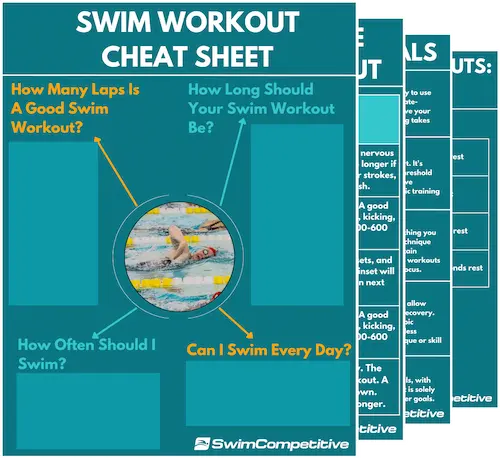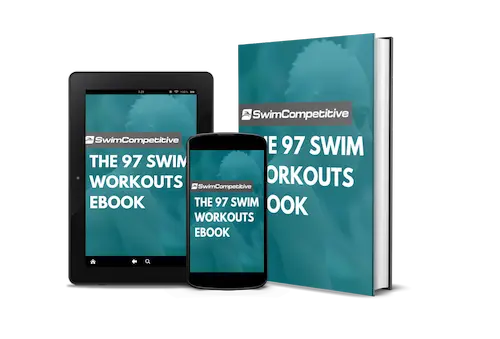As competitive swimmers, we are always looking to become faster and better swimmers. (Swimming strength training can help us achieve this.) We want to push our bodies to the limits at swimming practice, but also away from the pool to optimize our chances of becoming the best possible swimmer that we can be.
Swimming strength training can be very beneficial for competitive swimmers. It will allow important muscle groups to be strengthened, ultimately allowing for better swimming performance in races. Swimming strength training involves many complex aspects, but at the end of the day, it will allow you to gain an edge.
Many swimming coaches and swimmers might still be a bit skeptic when it comes to swimming strength training and might avoid it completely.
This is definitely not the right approach to take. I truly believe that swimming strength training can be very beneficial for competitive swimmers.
Sure, it might not be for all swimmers, but it definitely can benefit others.
In this article, I will be answering a few questions about swimming strength training and I will also be explaining a few very important aspects of it.
Here is a quick list of what we are going to discuss in this article-
- What about swimming strength training and injuries?
- What muscle groups are the most important for swimmers to train?
- How often should swimmers do strength training?
- What are the best strength training exercises for swimming?
- How to ensure you keep progressively getting stronger.
- The importance of creating a set swimming strength training routine.
- What role does nutrition play in swimming strength training?
In recent years swimming strength training has started to become more and more popular with Olympic swimmers like Adam Peaty (among many others) taking a strength training-based approach to allow him to become faster in the water.
Before we start I just want to clarify that I think it’s important for all swimmers to experiment with swimming strength training for a few months and see where it takes them. Some may enjoy it and find it beneficial and others might not enjoy it so much, which is also fine.
There are alternate methods that you can try as well, such as bodyweight training, resistance bands, etc.
What About Swimming Strength Training and Injuries?
One of the biggest reasons why swimmers and coaches might avoid swimming strength training is because of the common misconception that swimmers can easily get injured. This is simply not the case.
Sure, many athletes that are new to strength training do get injured. This, however, is a case of not being informed correctly and not having the right information available to them. It is also, because of a lack of care for learning proper technique and form for high resistance exercises.
If you take the right approach to strength training your chances of getting injured is very low. Yes, there is still a small chance, but at the same time, there is a chance of getting injured on any other cross-training method as well.
This is one of the risks as athletes that we have to take in order to become the best possible versions of ourselves. So how exactly do you avoid getting injured from strength training?
There are 3 main ways of avoiding injuries. All of them are very important and should be taken seriously.
- The first way to avoid injuries is to warm up properly. Make sure to do some dynamic stretching, include some foam rolling and also make sure to include some light exercises to get the blood flowing. Rowing, skipping or light jogging are great ways of getting your muscles warmed up.
- The second way to avoid injuries is to make sure to execute proper technique on every exercise. You can hire a trainer to help you achieve proper technique or you can record yourself doing the exercises and then adjust your technique from there if needed.
- Lastly, you never want to be using more weight than your body can handle. There is a fine line when deciding what is too much and too little. Ultimately, you want to be using a weight load that challenges you but doesn’t cause your form and technique to fall apart.
Make sure to read up on proper form and technique on the internet, there is a lot of information available out there.
What Muscle Groups Are the Most Important for Swimmers to Train?
The second question regarding swimming strength training that we are looking at is what muscle groups you should train. Swimming in general uses almost all of your muscle groups, but there are certainly a few large muscle groups that play a more important role.
Here is a quick list of some of the biggest and most important muscle groups that swimmers should look at strengthening-
- Latissimus dorsi muscle group. (Lats).
- Pectoralis major and minor muscle group. (Chest).
- Trapezius muscle group. (Upper-back).
- Triceps. (Arms).
- Abdominal muscle group. (Core)
- Quadriceps and hamstrings. (Legs).
How Often Should Swimmers do Strength Training?
The third question regarding swimming strength training, we are looking at today is going to be the frequency of your strength training. Frequency is important when looking at strength training because it promotes muscle protein synthesis, which promotes muscle and strength gain.
You want to be training each of your main muscle groups at least 2 – 3 times per week for optimal results. But you also don’t want to be training so much, that it interferes with your swimming practices. That would simply be counter-productive. There are 2 general training splits that I recommend swimmers try out.
1. Full Body Training Split
The first is going to be a 3 day per week full body strength training split.
During this strength training split, you will be doing 3 full body workouts targeting all of your muscle groups. This is good since you have a high-training frequency, but volume might lack a bit since workouts would get too long. It will look something like this-
- Monday- Full body workout.
- Tuesday- Rest day.
- Wednesday- Full body workout.
- Thursday- Rest day.
- Friday- Full body workout.
- Saturday- Rest day.
- Sunday- Rest day.
2. Upper /Lower Training Split
This is going to be slightly less frequency for each muscle group, but you are going to be able to target each muscle group with more volume. It will look something like this-
- Monday- Upper body workout.
- Tuesday- Lower body workout.
- Wednesday- Rest day.
- Thursday- Upper body workout.
- Friday- Lower body workout.
- Saturday- Rest day.
- Sunday- Rest day.
What Are the Best Strength Training Exercises for Swimming?
Now that we have covered many of the critical aspects of swimming strength training, we are going to have a look at some of the best exercises to actually develop this strength and train the muscle groups that we listed as important.
When you are choosing dryland exercises for a strength training program, you primarily want to focus on choosing compound exercises. Meaning exercises that target multiple muscle groups at once. Your primary focus is developing strength, so that’s why you aren’t choosing isolation exercises like bodybuilders would typically do.
Here is a quick list of some of the best exercises you can do to develop your overall strength and power as a competitive swimmer-
Upper Body Exercises
- Bench Press.
- Pull Ups (Check out my article where I explain why all swimmers should do pull-ups).
- Chin Ups.
- Dips.
- Straight bar dips.
- Barbell Rows.
- Overhead Press.
- Push Ups.
- Cable push downs.
- Jack Knifes.
- Planking.
- Russian Twist.
Related: Upper body exercises.
Do You Want to Make Every Lap Count?
Stop wasting your time in the pool feeling lost and doing directionless swim workouts, and start training effectively! Our ebook contains 97 structured and goal-orientated swim workouts to help you become a better, faster, and fitter swimmer. Whether you’re a complete beginner or a seasoned pro, there are a multitude of workouts for every type of swimmer.
Lower Body Exercises
- Back squat
- Front squat
- Box squats
- Deadlifts
- Romanian deadlift
- Hex bar deadlift
- Lunges
- Pistol squat
- Calve Raises
- Leg press
Related: Leg exercises for swimmers.
How Many Reps and Sets Should I Do?
Now that we have covered some of the best exercises to build strength. We are going to discuss how many reps and sets of each you should do. There are a few different rep ranges that target different goals.
The rep range we are going to want to use the most is going to be 5-6 reps. This rep range is optimal for building strength and avoiding injury. It is important to remember that lower reps mean higher weight or higher resistance.
So if you can easily bench press say 10 reps for 50kg then you are going to want to increase that until you can only bench about 7-8 reps, which would most likely be around 55kg. You do not want to completely exaust yourself so you need to leave a little bit in the tank.
What I mean by this is you may be able to bench 55kg for 8 reps, but then you have nothing left in the tank, so then you bench it for 6 reps and that allows you to do a few sets and ultimately get stronger.
So the general scheme we are looking at here is that you want to do 5-6 reps for strength gains and you want to leave about 2 reps in the tank.
Higher rep ranges can also be used to strengthen lacking or small muscle groups. So, for instance, say your triceps need a little more size, then you can always just add a tricep exercise and do a few sets of 10-15 reps.
I recommend that you mix up your rep schemes between high and low for optimal results. In terms of sets, you will generally be best off with about 3 – 4 sets for each exercise.
How to Ensure You Keep Progressively Getting Stronger
You might be wondering how to go about optimally progressing each week and becoming stronger every time you train. The key to becoming stronger is “progressive overloading”
Progressive overloading basically means to slowly increase reps, sets, and weight to ultimately put more resistance on your muscles and force them to grow and become stronger. I recommend swimmers to progressively overload every 1-2 weeks.
You can quite easily do this in a few ways, which I already briefly mentioned-
- Increase the amount of weight you use.
- Increase the number of reps you do.
- Add more sets
Before we move on I just want to quickly touch on the different types of ‘strength’ we can train for. There are 3 main ‘strengths’- Maximal strength, strength endurance, and peak power. The general rule is to train for maximal strength since this will make you stronger at everything else.
The Importance of Creating a Set Swimming Strength Training Routine
Setting up a swimming strength training program, plan or routine is very important. Way too many swimmers go into the weight room with no idea of what they are going to do that day. This is a really bad idea since you won’t be able to effectively progress and become stronger.
Before you start doing strength training you need to set up a program with what training split you are planning to follow, what exercises you are going to do, how much weight you are going to use, how many reps and sets you are going to do and how you are planning to progressively overload.
This will allow you to properly and effectively make progress with your strength training and become a better swimmer.
What Role Does Nutrition Play In Swimming Strength Training?
The last aspect we are going to touch on is nutrition. It is important to note that nutrition also plays a big role in becoming stronger. Your muscles are going to have a higher load of resistance on them now and they are going to require more protein to recover.
Your body is going to be burning more calories because you are doing extra training away from swimming practice. That means you are going to have to replace those calories by eating more high-quality foods.
I have written many awesome articles about nutrition that could help you optimize your swimming strength training and your swimming practices. I will list some of them below-
Use Strength Training to Swim Faster
As you can see there are many aspects that go into structuring an effective strength training routine. All of these aspects are important and should be taken seriously if you want to maximize your strength training results.
I also think it’s quite clear that swimming strength training can be beneficial for competitive swimmers. It is important to remember to listen to your body. If you feel like you need some more time to recover, then take a day off it will only benefit your swimming practices, which are much more important.
I hope that this article has provided you with some useful information to get you started on your swimming strength training journey.





